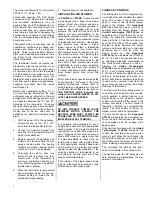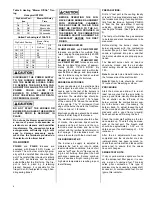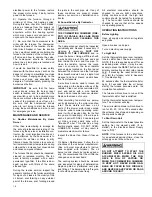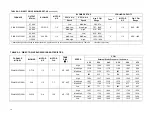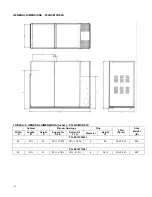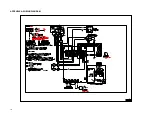
10
electrical power to the furnace, restore
the proper motor wiring. Finally, restore
power to the furnace.
E) Operate the furnace through a
minimum of three full heating cycles.
During this time, check for fuel oil leaks,
gross air leakage from the supply air
ductwork, unusual noises originating
anywhere within the heating system
which may cause some concern or an-
noyance to the home owner, etc.
F) Be sure that the homeowner is fa-
miliar with the furnace. The homeowner
should be aware of the location of elec-
trical circuit breaker or fuse, the location
of any electrical switches controlling the
furnace, the location of the oil tank shut-
off valve and how to operate the valve.
The homeowner should be informed
where the oil tank gauge is located and
how to read it.
It would be beneficial to review safety
issues with the home owner, such as the
danger of storing combustibles too close
to the furnace, hanging anything on the
furnace vent pipe, and especially the
dangers of indiscriminately pressing the
burner reset button.
IMPORTANT
: Be sure that the home
owner knows where the burner reset
switch is located, and is aware that the
reset switch is not to be activated more
than once without a thorough look for the
cause of the problem, (lack of fuel, etc.).
Be sure that the homeowner knows
when to quit trying to start the furnace
during these conditions and who to call
for emergency service.
MAINTENANCE AND SERVICE
A: Routine Maintenance By Home
Owner
Other than remembering to arrange for
the annual professional servicing of the
furnace by the service or installation con-
tractor, the most important routine ser-
vice performed by the homeowner is to
maintain the air filter or filters. A dirty
filter can cause the furnace to over-heat,
fail to maintain indoor temperature during
cold weather, increase fuel consumption
and cause component failure.
The furnace filter(s) should be inspected,
cleaned or replaced monthly. The fur-
nace is factory equipped with a semi-
permanent type filter. If the filter is dam-
aged, replace with filters of the same
size and type.
During the routine service, inspect the
general condition of the furnace watching
for signs of oil leaks in the vicinity of the
oil burner, soot forming on any external
part of the furnace, soot forming around
the joints in the vent pipe, etc. If any of
these conditions are present, please
advice your service or installation con-
tractor.
B: Annual Service By Contractor
THE COMBUSTION CHAMBER (FIRE-
POT) IS FRAGILE. USE CARE WHEN
INSPECTING AND CLEANING THIS
AREA
.
The heat exchanger should be inspected
periodically and cleaned if necessary. If
cleaning is necessary,
SHUT OFF
POWER TO THE FURNACE
and re-
move the burner. Using a stiff brush with
a wire handle, brush off scale and soot
from inside the drum and flue pipe. To
clean the radiator, remove the round
cover or covers on the inner radiator
access pipes located on the front panel
between the oil burner and the flue pipe.
Rear breech models have a single front
cleanout and front breech models have
two front cleanouts.
A wire brush can be used to loosen dirt
and debris on the inside surfaces of the
radiator. Clean out all accumulated dirt,
soot and debris with a wire handled
brush and an industrial vacuum cleaner.
Replace the clean-out covers.
Most circulating fan motors are perma-
nently lubricated by the motor manufac-
turer. These motors will have no oil
ports. If the blower motor does contain
oil ports, under normal operating condi-
tions it will not require oiling for the first
two years. Oil sparingly; a few drops in
each oil port with SAE 20 non-detergent
oil. Oiling is most easily done with a
"tele-spout" oiler. This oiler has a long
flexible plastic spout. DO NOT OVER-
LUBRICATE. Excess oil may result in
premature electric motor failure.
Inspect the blower fan. Clean it if neces-
sary.
Oil Burner Maintenance: Follow the in-
structions of the oil burner manufacturer.
(See oil burner manufacturer's instruc-
tions supplied with furnace). The oil
burner nozzle should be replaced annu-
ally. We recommend that the oil filter be
changed on an annual basis.
The venting system should be cleaned
and inspected for signs of deterioration.
Replace pitted or perforated vent pipe
and fittings. The barometric draft regula-
tor should open and close freely.
All electrical connections should be
checked to ensure tight connections.
Safety controls such as the high limit
controls should be tested for functional-
ity. The fan control functions should be
checked to ensure that all fan speeds
are operating properly.
OPERATING INSTRUCTIONS
Before Lighting
Open all supply and return air registers
and grilles.
Open all valves in oil pipes.
Turn on electric power supply.
To Light Unit
Set the thermostat above room tempera-
ture to call for heat. The burner will start.
NOTE: If the furnace has been off for an
extended period of time, it may be nec-
essary to press the RESET button on the
primary combustion control relay, (once
only). If pressing the reset button does
not start the furnace, refer to Appendix
C, Troubleshooting.
45 seconds after the thermostat calls for
heat, (30 seconds after the oil burner
starts), the furnace becomes warm, the
circulation fan will start.
The furnace will continue to run until the
thermostat call for heat is satisfied.
Set the thermostat below room tempera-
ture. The oil burner will stop.
The air circulation blower will continue to
run for 60, 90, 120 or 150 seconds after
the oil burner has stopped, depending on
the dip switch settings.
To Shut Down Unit
Set the thermostat to the lowest possible
setting. Set the manual switch (if in-
stalled) in the Electrical Power Supply
Line to "OFF".
NOTE
: If the furnace is to be shut down
for an extended period of time, close the
oil supply valve to the oil burner.
DO NOT ATTEMPT TO START THE
BURNER WHEN EXCESS OIL HAS
ACCUMULATED, WHEN THE FUR-
NACE IS FULL OF VAPOUR, OR
WHEN THE COMBUSTION CHAMBER
IS VERY HOT. NEVER BURN GAR-
BAGE OR PAPER IN THE FURNACE,
AND NEVER LEAVE PAPER OR RAGS
AROUND THE UNIT
.
Содержание P3HMX12F08001
Страница 16: ...16 APPENDIX A WIRING DIAGRAM ...







